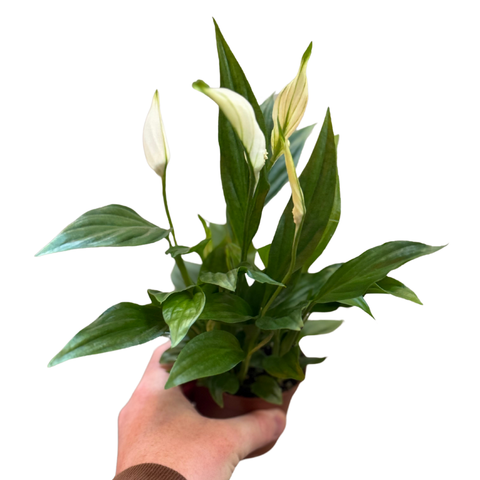


Peace Lily - Spathiphyllum ‘Pearl Cupido’
Aroma QuartzSpathiphyllum ‘Pearl Cupido’
Common Names: Peace Lily, Pearl Cupido Peace Lily
Full Botanical Name: Spathiphyllum ‘Pearl Cupido’
Country and/or Region of Origin: Native to tropical regions of Central and South America
Overview:
Spathiphyllum ‘Pearl Cupido’ is a refined, compact variety of the beloved Peace Lily, admired for its lush green foliage and graceful white blooms that resemble calla lilies. The signature “pearls” are actually modified leaves known as spathes, which cradle the central spadix—creating a timeless symbol of purity and calm. Easy to care for and forgiving of less-than-perfect conditions, this elegant houseplant is perfect for bringing a sense of serenity to your space.
Growing Conditions in Native Habitat:
In the wild, Peace Lilies thrive in the understory of tropical rainforests, growing in the rich, humid shade beneath the forest canopy.
Care Guide
Light: Prefers bright, indirect light. Tolerates lower light levels, though flowering may be reduced. Avoid direct sunlight, which can scorch the leaves.
Ideal Room: A perfect fit for bedrooms, bathrooms, offices, or any space where soft, filtered light is present.
Feeding: Feed every 6–8 weeks during spring and summer with a balanced, diluted liquid houseplant fertilizer. Avoid overfeeding.
Humidity: Enjoys moderate to high humidity. Boost with misting, a humidity tray, or by grouping with other plants to create a microclimate.
Ideal Temperature: Prefers consistent warmth between 65°F and 80°F (18°C to 27°C). Protect from cold drafts and sudden temperature drops below 55°F (13°C).
Watering: Water when the top inch of soil feels dry. Peace Lilies are expressive—if it starts to droop, it’s ready for a drink. Ensure excess water can drain away to prevent root rot.
Pet/Child Safe: Mildly toxic if ingested. Can cause irritation to the mouth and digestive tract. Keep out of reach of children and pets.
Soil Type: Use a rich, well-draining potting mix. A blend of indoor plant compost with added perlite or coco coir works well.
Propagation: Best propagated through division. Separate healthy clumps of roots when repotting to create new plants.
Eventual Height and Spread: Grows up to 12–18 inches (30–45 cm) tall and wide—ideal for tabletops, shelves, or small floor pots.
Growth Rate: Moderate. Slows down in winter but picks up again with warmth and light in spring and summer.
Pests and Treatment: Susceptible to common pests such as spider mites, mealybugs, and aphids. Treat with neem oil or insecticidal soap and clean leaves regularly.
Repotting: Repot every 1–2 years or when the plant becomes root-bound. Choose a slightly larger pot with drainage.
Pruning: Trim spent flowers and yellowing leaves at the base to encourage new growth and maintain a tidy appearance.
Air Purification: Peace Lilies are renowned for their air-purifying abilities, filtering toxins such as formaldehyde, benzene, and carbon monoxide—making them a wellness-boosting addition to any home.
Folklore: Often gifted as a symbol of peace, sympathy, and healing. Its white blooms are said to represent hope and spiritual renewal, making it a meaningful plant for quiet spaces and moments of reflection.
